Hooge Visit 2000
The Memorial Stone Dedication at Hooge Saturday, 29th July 2000
The Liverpool Scottish in the Ypres Salient in Belgium
Unveiling and Dedication with pictures
Menin Gate and Subsequent Events
The town of Ieper (Ypres) has accepted, from the Liverpool Scottish, a stone bearing the Regimental Badge which has been placed on the battlefield at Bellewaarde near the town. The battle is known in the Regimental History as the Battle of Hooge, the first major action of the battalion which had arrived in France in November 1914. The stone is a memorial to all those who served in the Liverpool Scottish throughout the past century. The stone was dedicated on Saturday 29th July 2000. There was a strong presence of Old Comrades and serving Liverpool Scottish soldiers from A (King's) Company of the Territorial Army's newly-formed King's and Cheshire Regiment together with a civic and church representation from Liverpool.
The dedication was conducted by the Rev Canon Nicholas Frayling,Rector of Liverpool, and Father Boni Van Looveren of Ieper.

History
In the Battle of Hooge on the 16th June 1915, known officially as the 'First Action at Bellewaarde',. "of 23 officers and 519 other ranks who went into action, only two officers .... and 140 men came through untouched'. Four officers and 75 other ranks were killed; 11 officers and 201 other ranks were wounded and 6 officers and 103 other ranks were reported as missing (almost all of whom were subsequently reported as killed).' (From The Liverpool Scottish 1900 -1919 by Lt. Col A.M. McGilchrist published by Henry Young and Sons 1930)
The action involved the 9th Brigade (of which the Liverpool Scottish was part) and the 7th Brigade, both of the 3rd Division of the British Expeditionary Force. The objective was the German trenches on top of Bellewaarde Spur near Eailway Wood about 4km east of Ieper/Ypres just north of the Menin Road.
The photograph above was taken by Private Fyfe of the Liverpool Scottish, a press photographer by profession, lying wounded on the German frontline. An artillery observation party (an officer and his signaller) can be seen going forward . The banner that can be seen on the right hand side is to indicate the progress of the attacking troops to the friendly artillery so that supporting fire may be lifted and moved on. Wounded men are lying in the foreground and a shell is exploding in Railway Wood. This panorama of two photographs is from the Regimental History and are also in the Imperial War Museum collection. The Museum Archive holds one of Fyfe's own prints.
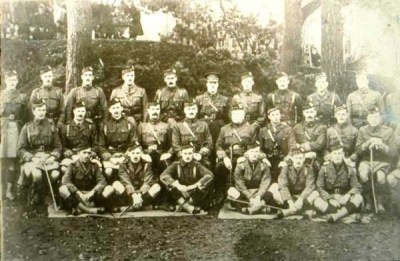 The picture to the left shows the officers of the Liverpool Scottish taken at Tunbridge Wells prior to the battalion's [1st/10th (Scottish) Battalion, The King's (Liverpool Regiment)] departure for France and Belgium in Nov 1914. After the charge at Hooge in June 1915, nearly half of them were dead and the majority of the remainder had been wounded. (Picture from the Liverpool Scottish Museum archives) More detail of the Liverpool Scottish in the First World War in the trenches and at Hooge can be found on the Regimental History page of the Museum Trust website.
The picture to the left shows the officers of the Liverpool Scottish taken at Tunbridge Wells prior to the battalion's [1st/10th (Scottish) Battalion, The King's (Liverpool Regiment)] departure for France and Belgium in Nov 1914. After the charge at Hooge in June 1915, nearly half of them were dead and the majority of the remainder had been wounded. (Picture from the Liverpool Scottish Museum archives) More detail of the Liverpool Scottish in the First World War in the trenches and at Hooge can be found on the Regimental History page of the Museum Trust website.
The Battlefield Today
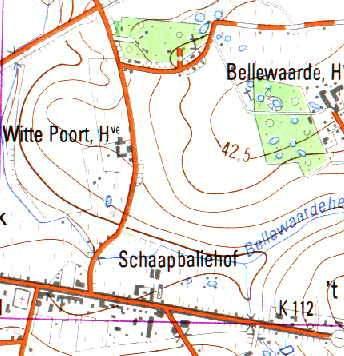 The area is shown on the modern map to the left (Map Nationaal Geografisch Institut of Belgium 28/1-2 scale of 1:25000 available from the Ieper Tourist Office at a cost of about £5)
The area is shown on the modern map to the left (Map Nationaal Geografisch Institut of Belgium 28/1-2 scale of 1:25000 available from the Ieper Tourist Office at a cost of about £5)
The section shown is about 3 km to the East of Ieper/Ypres and the Menin Road runs left to right on the bottom edge. Running north from the Menin Road to Railway Wood is 'Cambridge Road' and the distance between the southern and the northern junction is about 600 metres. It was from the Cambridge Road that the Liverpool Scottish advanced east in the area between Railway Wood and Witte Poort Farm towards Bellewaarde Ridge. Note the number of water-filled craters along the ridge line. The position of the memorial is on the bend in the track just below the 'll ' in Bellewaarde.
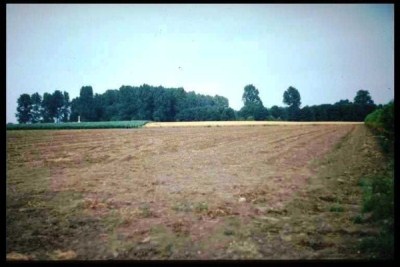 The view from just South of Witte Poort Farm uphill to the east towards the white Cross of Sacrifice of Royal Engineers Grave at the top of Bellewaarde Ridge is shown here in the photo to the right.
The view from just South of Witte Poort Farm uphill to the east towards the white Cross of Sacrifice of Royal Engineers Grave at the top of Bellewaarde Ridge is shown here in the photo to the right.
In 1915 the Liverpool Scottish advanced up the hill to the left of the picture. The Liverpool Scottish memorial is at GR 956337 just to the right (south east) of the RE Grave Cross of Sacrifice.
 The view from the RE Grave at the the top of Bellewaarde Ridge looking West back down the hill toward Ieper (Ypres). The towers of the Cloth Hall and the Cathedral can be seen in the enlarged photo. Railway Wood can just be seen at the right of the picture. In the foreground the Cross of Sacrifice marks the grave of twelve men who worked with 177th (Tunnelling) Company, Royal Engineers, and who were killed and are buried in the tunnels below. The 'White Horse of Hanover' regimental badge of The King's (Liverpool Regiment) that can be seen on the enlarged picture on the base of the Cross commemorates Edward Poulton, a soldier of the Liverpool Scottish who was attached to the Tunnelling Company. The Liverpool Scottish advanced both through Railway Wood and over the open ground which can be seen in the photo.
The view from the RE Grave at the the top of Bellewaarde Ridge looking West back down the hill toward Ieper (Ypres). The towers of the Cloth Hall and the Cathedral can be seen in the enlarged photo. Railway Wood can just be seen at the right of the picture. In the foreground the Cross of Sacrifice marks the grave of twelve men who worked with 177th (Tunnelling) Company, Royal Engineers, and who were killed and are buried in the tunnels below. The 'White Horse of Hanover' regimental badge of The King's (Liverpool Regiment) that can be seen on the enlarged picture on the base of the Cross commemorates Edward Poulton, a soldier of the Liverpool Scottish who was attached to the Tunnelling Company. The Liverpool Scottish advanced both through Railway Wood and over the open ground which can be seen in the photo.
 Another view of Railway Wood can be seen in the photo to the right. The viewpoint is from the top of the Bellewaarde Ridge by the RE Grave and the camera is looking north west. The wood looks rather leafier on this picture (taken July 1998) than in Private Fyfe's photograph of June 16th 1915 at the head of the page.
Another view of Railway Wood can be seen in the photo to the right. The viewpoint is from the top of the Bellewaarde Ridge by the RE Grave and the camera is looking north west. The wood looks rather leafier on this picture (taken July 1998) than in Private Fyfe's photograph of June 16th 1915 at the head of the page.
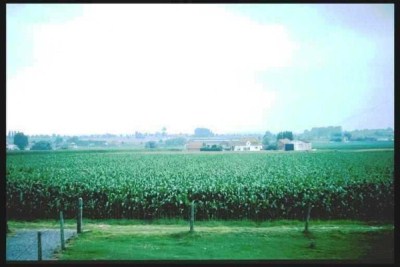 The photo to the right is taken looking west from the RE Grave on the crest of the Bellewaarde Ridge and shows Witte Poort Farm on the 'Cambridge Road'. Cambridge Road runs across the picture and roughly marks the Start Line of the attack on 16th June 1915. The right hand edge of this picture marks roughly the left hand (or southern boundary) of the Liverpool Scottish area on 16th June 1915. In 1915 a hedgerow running towards the hill crest from Cambridge Road marked this boundary. Today, the hedge no longer exists but the fields which it divided are still in different ownership and in 2000 the division was clearly seen as different crops were in each of the fields.
The photo to the right is taken looking west from the RE Grave on the crest of the Bellewaarde Ridge and shows Witte Poort Farm on the 'Cambridge Road'. Cambridge Road runs across the picture and roughly marks the Start Line of the attack on 16th June 1915. The right hand edge of this picture marks roughly the left hand (or southern boundary) of the Liverpool Scottish area on 16th June 1915. In 1915 a hedgerow running towards the hill crest from Cambridge Road marked this boundary. Today, the hedge no longer exists but the fields which it divided are still in different ownership and in 2000 the division was clearly seen as different crops were in each of the fields.
The Stone Memorial
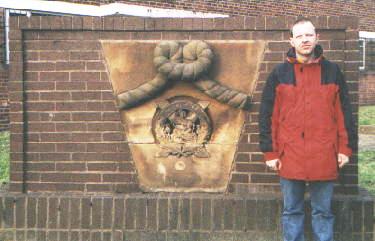
The stone was the keystone above the entrance at the Fraser St (Liverpool) Barracks of the Liverpool Scottish. It shows the badge of the 10th (Scottish) Battalion,The King's (Liverpool Regiment) with a piece of rope work decoration above it. In 1967, on the disbandment of 1st Battalion The Liverpool Scottish, Queen's Own Cameron Highlanders, V (The Liverpool Scottish) Company of the Highland Volunteers was formed. Most of the Fraser St. building was demolished and the stone went into storage after it had been salvaged from the site. In about 1978, it was relocated outside the new HQ in Childwall in Liverpool (Forbes House) where it was set in a brickwork plinth about five feet high and seven feet across . The stone itself is about four feet high and wedge-shaped. On the closure of Forbes House in 1999 following the Strategic Defence Review, it was decided to offer it to the Belgian town of Ieper (Ypres) where friendships have been established during the dedication of the Chavasse Memorial in Brandhoek churchyard in 1997 and during previous visits.
Moving and Locating the Memorial
The stone arrived in Ieper in mid-April 2000, taken across the Channel by Captain Gordon McConnell in a seven tonne truck provided by Parcel Force. It was accompanied by two tons of Liverpool granite setts (street paving blocks or cobblestones) donated by the City of Liverpool to act as a surround to the memorial. Photographs the delivery are below. The stone has been placed on the crest of the Bellewaarde Spur near the RE Grave Memorial so that in viewing it from the site, the observer looks west towards the Start Line near Cambridge Road and over the hillside up which the Liverpool Scottish advanced on 16th June 1915. The ground has been donated by a local landowner and is in the area of Bellewaarde Farm, occupied by Mr and Mrs Walter Huygehbaert. Beyond is Ieper (Ypres). The plaque with the stone carries an inscription in English and in Dutch, the language of the people of Flanders. The photograph below shows the arrival of the stone in Ieper.
Photographs of the lorry loaned by Parcelforce (driven by Captain McConnell) delivering to Ieper - courtesy of Fernand Vanrobaeys of Ieper Town Hall
An open letter to the people of Merseyside from Colonel Ian Paterson OBE TD (Chairman of the Liverpool Scottish Regimental Council) resulted in several families, whose fathers and grandfathers fought with the Liverpool Scottish, contacting us and they accompanied us on our journey.
Previous page: Regimental Family Trips
Next page: Memorial Dedication 2000



